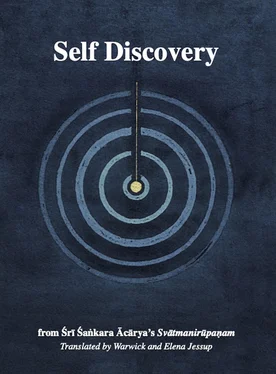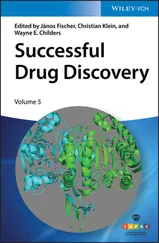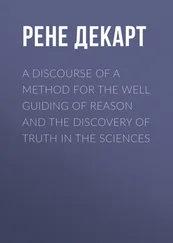bhrānti false perception, graha demon, upaśānti cessation, pāṃsumaya consisting of dust, yasya (yad) of which, bhasita ashes, ā√tan to spread.
1The Sanskrit word for ‘duality’ here is ‘ dvandva ’ oſten referring to pairs of opposites such as pleasure and pain. ‘ Dvandva ’ is also used in this line in the sense of ‘the two feet’ of the teacher which are venerated. This image indicates the humility needed on the spiritual path.
2The Sanskrit word here is ‘ bhrānti ’, literally ‘wandering’, and coming to mean ‘perplexity, confusion, doubt, error, false opinion’, referring to false perception, here the perception of duality, particularly the duality of subject and object.
2
I bow to that best of teachers, who is compassionate and destroys all doubts, whose feet point out the non-dual experience 3known as ‘That’ 4.


deśika teacher, vara best, dayālu compassionate, √vand to bow to, aham (asmad) I, nihata destroyed, nikhila all, sandeha doubt;
yat (yad) that, caraṇa foot, dvaya pair, advaya non-dual, anubhava experience, upa√diś to point out, tat (tad) That, pada word, artha meaning.
3This is ‘ advaya anubhava ’ in Sanskrit. Experience of the non-dual may seem self- contradictory, but the word for experience ‘ anubhava ’ literally means ‘being along with’. Hence this type of experience is not experience of something separate.
4This is a reference to such expressions in the Upaniṣads as ‘You are That’ ( Chāndogya Upaniṣad 6.8.7) in which ‘That’ means the ultimate reality.
3
Scorched by the blaze of worldly illusion, the disciplined aspirant is enlightened by the teacher through words enabling discovery of one’s own Self 5.


saṃsāra worldly illusion, dāva conflagration, pāvaka fire, santapta scorched, sakala all, sādhanā spiritual practice, upeta endowed;
sva own, ātman Self, nirūpaṇa discovery, nipuṇa capable, vākya sentence, words, śiṣya disciple, pra√budh to enlighten, guru teacher.
5The Sanskrit expression here gives the whole work its title ‘ Svātmanirūpaṇam ’. ‘ Nirūpaṇa ’ means ‘discovering, stating, determining, defining’, from the root ‘ rūp ’ with the prefix ‘ ni ’. ‘ Rūp ’ means ‘to form, figure, represent (especially on stage)’ and ‘ ni-rūp ’ to perform, indicate by gesture; to find out, discover, ascertain; to investigate, examine, search, consider, reflect upon.’
4
Who can doubt their own existence? 6Even if you have such a doubt the doubter is really your Self.


asti there is, exists, svayam oneself, iti thus, asmin (idam) in this, artha matter,
kasya (ka) of which, asti , saṃśaya doubt, puṃs person;
atra here, api even, saṃśaya , cet if, saṃśayitṛ doubter,
yaḥ (yad) who, saḥ (tad) he, eva really, bhavasi you are, tvam You.
6Śaṅkara here clearly distinguishes his teaching from doctrines which maintain that the Self does not exist. For Śaṅkara, the Self ( ātman ) and the Absolute ( brahman ), which are identical, are positive, and by nature being, consciousness and bliss ( sat-citānanda ). This topic is also discussed in Taittirīya Upaniṣad 2.6.1.
5
One who thinks ‘I am not’ thinks that the Absolute does not in truth exist. Fully realising 7‘I am’ one knows oneself as Absolute alone.


na not, aham (asmad) I, iti thus, √vid to think, to know, yaḥ (yad) who, asau (adas) that, satyam truly, brahman Absolute, eva verily, √vid , na , √as to be, iti ;
aham , √as , iti , vi√jn͂ā to know fully, brahman , eva , asau , svayam oneself, vi√jñā .
7The Sanskrit here is ‘ vijānan ’, the present participle of the root ‘ jñā ’, ‘to know’, with the prefix ‘ vi ’. ‘ Vi ’ here indicates thorough knowledge and experience in practice. The implication is that ‘I am’ is not fully realised if that awareness is attached to some activity.
6
You are Absolute. Therefore, the idea ‘I am not Absolute’ is only delusion. Through delusion there is division, wherein all difficulties 8have root.


brahman Absolute, tvam (yuṣmad) You, eva verily, tasmāt (tad) therefore, na not, aham (asmad) I, brahman , iti thus, moha delusion, mātra only, idam this;
moha , √bhū to be, bheda division, kleśa difficulty, sarva all, √bhū , tad that, mūla root.
8The Sanskrit word here is ‘ kleśa ’, which can be translated as ‘pain, affliction, distress, anguish’. There are, according to the Yoga Sūtras (2.3), five difficulties, namely, ignorance ( avidyā ), ego ( asmitā ), attachment ( rāga ), aversion ( dveṣa ), and obsession ( abhiniveśa ).
Читать дальше






















